What Is Development Aid?
Posted in: Programs
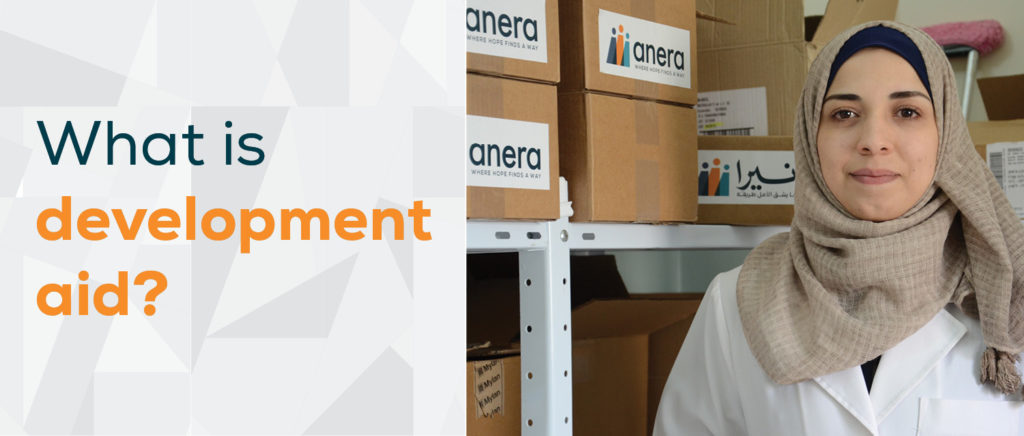

When many people think of foreign aid, they picture NGO workers providing medical care or handing out supplies in the aftermath of a hurricane or an earthquake. They might also think of providing food to people living in poverty. While this kind of immediate aid is, of course, crucial, it’s not the only type of aid. One other vital category of foreign aid is development aid.
While the scenarios described above involve meeting immediate needs, development aid focuses on meeting longterm needs. It goes deep to identify and address underlying causes and helps to create foundations to improve conditions over the long term.
Development Aid Definition
Generally, development aid includes monetary assistance in the form of direct grants, programs or training to support a developing country’s political, social or economic development. Developed countries often give development aid, but developing countries can do so as well. Modern development aid began with the Marshall Plan, through which the United States provided economic and technical assistance to European countries whose economies had suffered during World War II.
Today, development aid takes many forms. One country might supply development aid to another in the form of a direct monetary contribution, or it might provide technical expertise to help build the infrastructure to supply water to more citizens. It might also help teach the skills necessary to maintain and construct infrastructure.
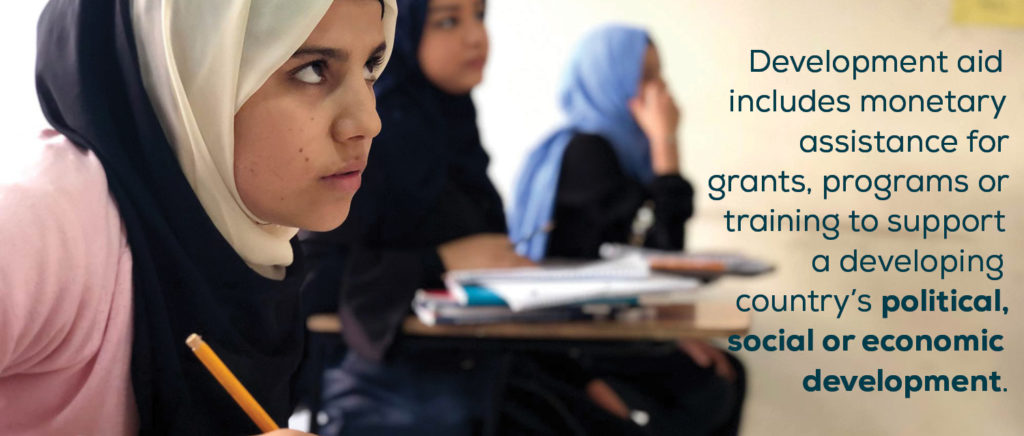

Development Aid vs. Humanitarian Aid
Development aid differs from humanitarian aid in what it aims to accomplish and in what timeframe it seeks to achieve its goals.
Generally, humanitarian aid is designed to relieve suffering in the short term or during emergencies. When a hurricane strikes in the Caribbean or when civil war breaks out and refugees need immediate access to food and medical care, humanitarian aid helps provide relief and save lives.
Development aid, on the other hand, is designed to alleviate long-term, systematic issues, such as entrenched poverty. It works over the long term by promoting economic, political, social or environmental development.
A medical development aid project might provide funding for reducing the prevalence of diseases such as malaria, tuberculosis or AIDS. An educational development aid project might provide resources for education in STEM fields to help local citizens improve their knowledge, find work in growing sectors and contribute to the local economy. An environmental development aid project might provide resources and education to help a developing country transition from fossil fuels to renewable resources to combat climate change and build a more sustainable economy for its citizens over the long term.
Types of Development Aid
Below are a few different types of development aid:
- Tied aid: Tied aid is spent in the country where it originates rather than in the country receiving the aid. At least 20 percent of developmental aid is formally tied. Much more is informally tied — that is, organizations spend money in countries other than the ones they are aiding, thereby supporting other economies rather than the developing economy.
- Untied aid: Conversely, untied aid can be spent wherever the recipient country wishes. For example, an NGO might spearhead efforts to build a new hospital in a developing nation and also hire local engineers and construction contractors to complete the work. By making use of untied aid, the donor country invests both in improved medical services and in the local economy.
- Project aid: Project aid typically involves providing funds for a specific project, such as building a school or hospital. Project aid can allocate NGO funds to different areas such as procuring supplies and coordinating workers.
- Resource aid: Resource aid helps supply resources in areas of critical shortages. These could be supplies of food and water in a drought- or famine-stricken area, or they could be medical supplies to refugee camps. NGOs might also use their local connections to create reliable supply lines in politically unstable areas.
- Technical aid: Development aid can also provide technical assistance and training to help give local business owners, construction workers, engineers, doctors, nurses and educators the tools they need to assist their communities and teach others.
- Voluntary aid: Voluntary aid incorporates volunteers who donate their labor as a form of aid. Doctors who use their medical skills in areas where there is a shortage of physicians or to help run vaccination programs, for example, provide voluntary aid. Volunteers who help provide educational programs in local communities do the same.
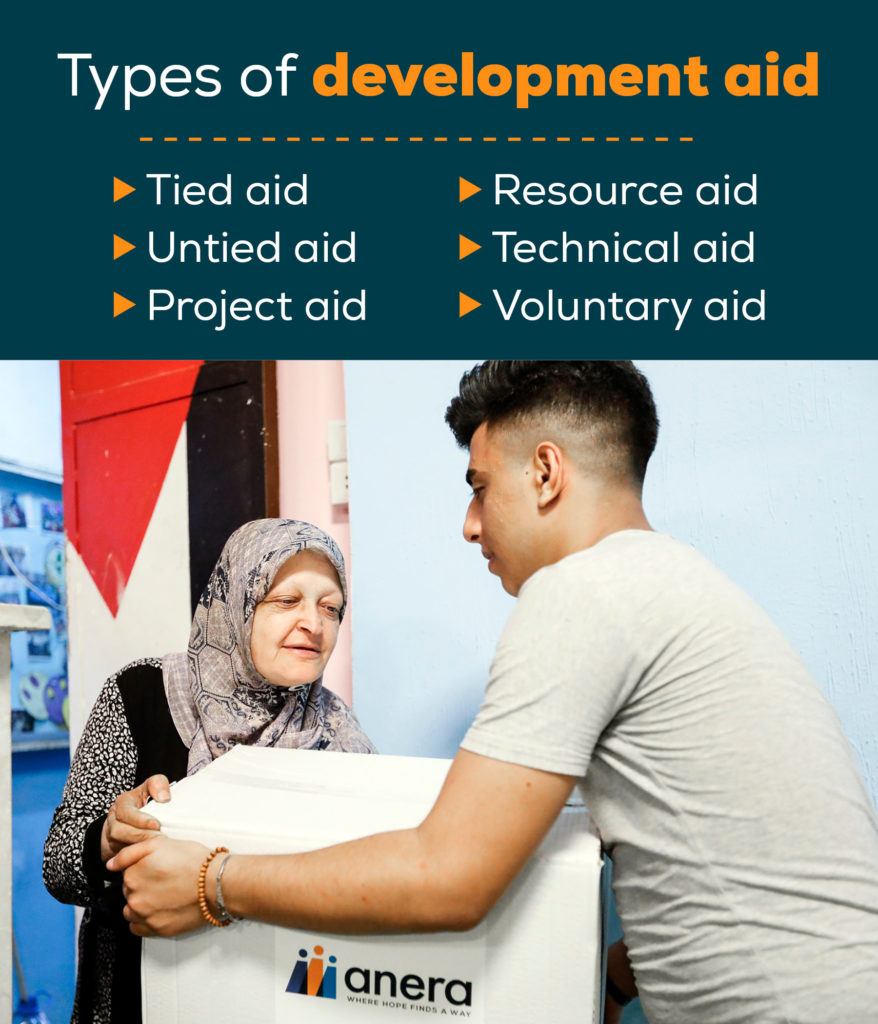

Examples of Development Aid
Refugee Aid
For decades, Lebanon has run refugee camps for Palestinian refugees. Because of the civil war in Syria, in recent years, many Syrian refugees have come to the camps as well in search of safety. For these reasons, Lebanon hosts the highest concentration per capita of refugees in the world. Almost 75 percent of the refugees in Lebanon lack legal residency, and many also lack documentation, so they are unable to get the services they need. They also face a competitive market for employment when they are legally eligible to work.
Although the Palestinian refugees who arrived in Lebanon in the 1940s lived in 12 formal camps, authorities have not permitted the construction of formal housing for Syrian refugees. Many refugees, therefore, live in makeshift shelters such as garages, warehouses, unfinished buildings and tents, where conditions are often primitive.
NGOs such as Anera have created programs in Lebanon to improve the lives of the refugees living in camps. Programs to provide math and literacy education help ensure young Syrians and Palestinians have the skills they need to gain jobs and help provide for their families. Training programs give preschool teachers the tools they need to provide safe, supportive educational environments for young children traumatized by war and dislocation. Health programs provide medical and dental treatments and health awareness programs, such as parasite detection training for mothers, to ensure that the refugee camps remain healthy places to live.
Jordan has also recently experienced an influx of refugees, mainly from Palestine and Syria. Like Lebanon, Jordan has shown exceptional generosity in hosting these refugees, but the conditions in the refugee camps are often difficult there as well. Refugees in Jordan often experience shortages of water and limited employment opportunities. In Jordan, Anera’s programs have distributed quilts, sewing kits and school kits to Palestinian refugees. Anera has also coordinated shipments of books for schoolchildren, helped facilitate refugee camp health visits to educate women about breast cancer and worked to meet the needs of refugees with disabilities.
Resource, Infrastructure and Education Aid
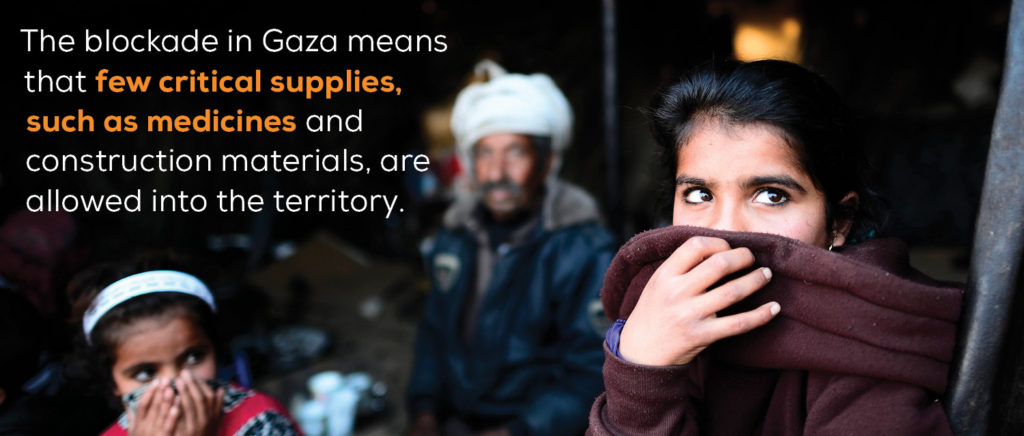

Development aid to provide resources and promote educational programs can help developing areas in several ways.
1. Gaza
The blockade in Gaza, for example, means that few critical supplies, such as medicines, are allowed into the territory.. These blockades also severely limit imports of materials used in construction and other trades as well as the export of Palestinian agricultural products. These restrictions contribute to the unemployment rate in Gaza, which is one of the world’s highest at over 50 percent.
The supply of electricity is also sporadic — limited, at best, to four hours per day. Residents have died from lighting their homes with candles and heating them with gas. Schoolchildren often bounce from neighborhood to neighborhood to study, trying to find a house with proper lighting. Poor sanitation is rampant because the sewage treatment plants cannot function without electricity, and much of the water is too contaminated to drink because the desalination plants needed to purify the water also cannot operate.
Programs such as Anera’s provide relief to Gaza’s densely packed and isolated population. Anera, along with other aid organizations in the region, works to provide food and medical care to Gaza’s residents. Because of longstanding relationships in the region, Anera can bring in medicines and medical supplies for hospitals. Programs to install water and sewer networks help ensure potable water and sanitary living conditions for some of Gaza’s residents. Rebuilding programs help restore schools damaged in a series of wars, and new school programs provide for the construction of new facilities and the training of new teachers so that more of Gaza’s children can receive an education.
2. The West Bank
The West Bank, by contrast, is a much larger region than Gaza. It is not subject to blockades, and its economy and employment rates are in better shape than Gaza’s. However, because the West Bank is divided into Areas A, B and C, many Palestinian residents must navigate checkpoints and barriers while going about their daily lives. Additionally, the military controls water access, so many Palestinians living in the West Bank lack access to clean water and sanitation services.
Many West Bank residents struggle to make a living. Agricultural production is a large part of the West Bank’s economy and way of life. However, limited space due to political division stifles crop production, as does limited access to clean water for irrigation. Additionally, checkpoints and transportation issues throughout the region limit farmers’ abilities to move and sell their crops.
Many of Anera’s programs in the West Bank focus on getting resources to farmers and families in need. We help install water networks to capture rainwater and bring precious water to families and their farms. We also help provide the intangible resources of education and medical services by helping to build schools and hospitals in the region. We invest in preschool education and teacher training so that the youngest West Bank citizens can get a quality head start on their learning and life skills. Likewise, we invest in physical health by helping to build sports centers that promote safe, fun sports participation, especially for West Bank girls.
Effectiveness of Development Aid
Economic observers have long debated the effectiveness of development aid, but recent research has found that it does, in fact, work. On the one hand, the social programs and medical assistance that result from foreign aid to developing countries can have significant positive impacts on developing communities. On the other hand, development aid, especially direct monetary disbursements, can be problematic for a couple of different reasons:
- Phantom aid: Sometimes, the aid money intended for good works ends up bankrolling administrative costs or sneaking into the pockets of the developing country’s political elite. “Phantom aid,” or aid that never reaches its intended recipients because it is looted, spent on consultants or administrative costs or reallocated for other purposes, does not help anyone. The country providing aid believes it has disbursed thousands of dollars in cash aid or resources, but the people who need help most see no benefits.
- Increased dependence: Foreign aid to developing countries can also have a negative effect if governments remain dependent upon foreign aid rather than using the support to boost their economies and move toward self-sufficiency.
A recent working paper by professor and renowned economist Mark McGillivray, also a project director at the United Nations University’s World Institute for Development Economics Research, takes on this issue. The paper argues that the bulk of recent research shows development aid is beneficial on a macroeconomic level, marking a turnaround from previous years in which research proved inconclusive. The vast majority of recent research on the subject finds that aid is effective in promoting developing countries’ economic growth.
Steve Radelet, former senior adviser on development to Secretary of State Hillary Clinton and now an economics professor at Georgetown University, also points out that a majority of research has shown a correlation between development aid and economic growth in developing countries. Even the Economist, a longtime skeptic of the efficacy of development aid, has recently touted foreign aid as a demonstrated booster of economic growth, if not always a cost-effective one.
Medical aid has been particularly effective. Compared to three decades ago, tuberculosis infections have dropped by 25 percent, and diarrheal diseases kill four million fewer children each year, largely because of international development aid efforts. PEPFAR, the President’s Emergency Plan for AIDS relief, has been a primary reason AIDS mortality has fallen by almost 50 percent since 2005 when the United States implemented the program. Similarly, deaths from malaria have declined by nearly half, saving approximately seven million lives, since the 2005 implementation of the President’s Malaria Initiative.
Foreign aid and development may not be a perfect solution, and it cannot solve the world’s problems alone, but its benefits are demonstrably life-changing and life-saving.
Partner With Anera to Help Support Vulnerable Communities
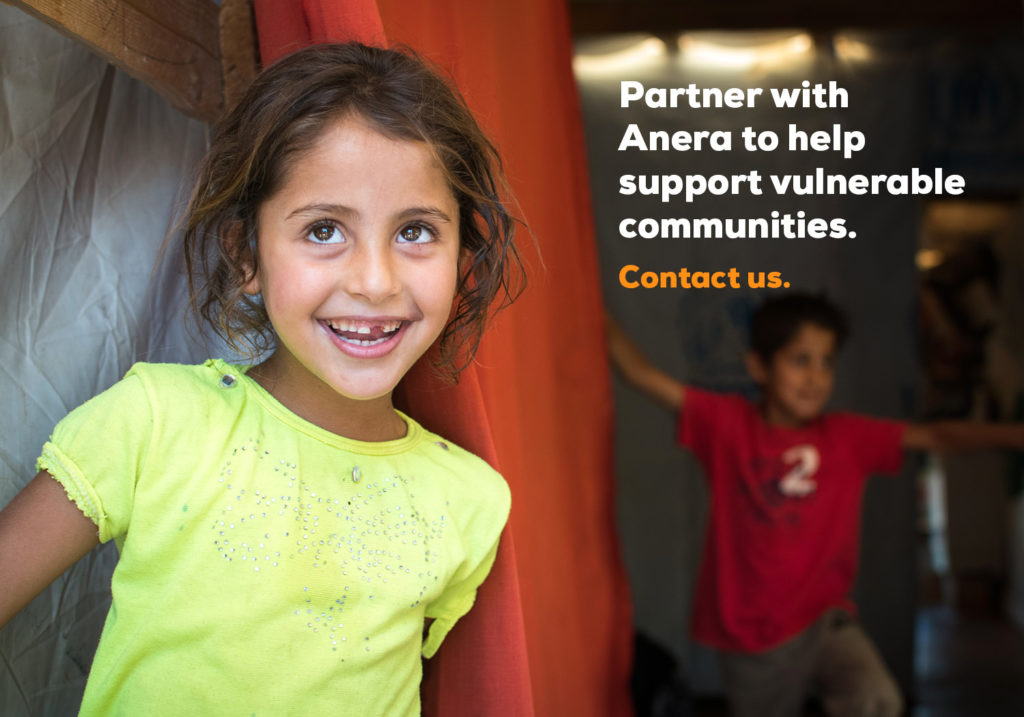

Anera has worked in Gaza and the West Bank for 50 years and in the Lebanese refugee camps for almost as long. Our newer partnership with Jordan has also been extremely fruitful. We help provide immediate disaster relief as well as long-term, sustainable development aid in the areas of education, medicine and economics. In 2018, we provided almost $70 million in aid programs, and we plan to continue in this work to change the world for the better.
When you donate to Anera, your gift goes directly toward helping vulnerable communities gain access to clean water, medical care and educational opportunities. For every dollar you give, 94 cents go straight to program work to help improve quality of life and give people the tools to invest in better futures for themselves and their families.
We also take steps to ensure your donations reach the intended recipients. Our local staff evaluates our partners to ensure they are eligible and capable of receiving our assistance. We also employ robust monitoring and evaluation systems that enable us to continually evaluate projects and their impacts. We ship all of our relief items to our warehouses or to reliable partners, and our staff assesses the shipments upon arrival. In addition, we undergo independent audits and U.S. government audits every year.
At Anera, we help refugees and others impacted by conflicts in the Middle East live with dignity and purpose by providing immediate emergency relief and supporting sustainable, long-term development. Get involved today to help refugees and other vulnerable communities in Palestine, Lebanon and Jordan.
OUR BLOG
Related
Part of a series on the impact of the war on all sectors of economic life within Gaza, Anera’s immediate response and plans for the future. Other posts cover housing, education, WASH, health and food production systems. Livelihood Recovery In Gaza, 57 years of occupation and…
InterAction and 50 Member CEOs, some of whom have organizations that work in Gaza, urge President Biden to take decisive and actionable steps to alleviate the humanitarian crisis in Gaza. Detailed within this letter are specific steps and commitments that…
